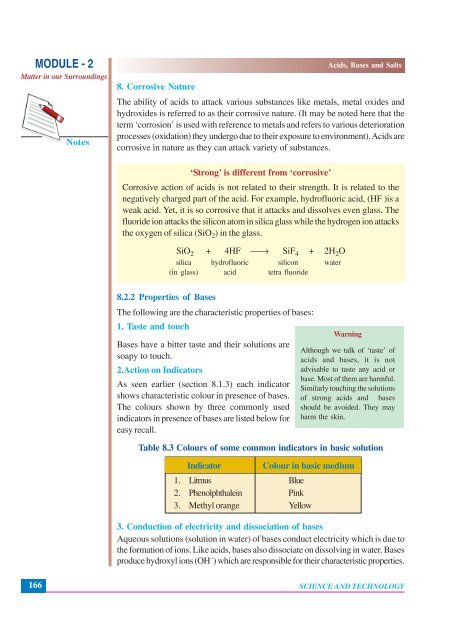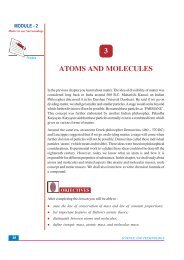8. Acids, Bases and Salts (41.1 MB)
8. Acids, Bases and Salts (41.1 MB)
8. Acids, Bases and Salts (41.1 MB)
You also want an ePaper? Increase the reach of your titles
YUMPU automatically turns print PDFs into web optimized ePapers that Google loves.
MODULE - 2<br />
Matter in our Surroundings<br />
Notes<br />
<strong>8.</strong> Corrosive Nature<br />
<strong>Acids</strong>, <strong>Bases</strong> <strong>and</strong> <strong>Salts</strong><br />
The ability of acids to attack various substances like metals, metal oxides <strong>and</strong><br />
hydroxides is referred to as their corrosive nature. (It may be noted here that the<br />
term ‘corrosion’ is used with reference to metals <strong>and</strong> refers to various deterioration<br />
processes (oxidation) they undergo due to their exposure to environment). <strong>Acids</strong> are<br />
corrosive in nature as they can attack variety of substances.<br />
‘Strong’ is different from ‘corrosive’<br />
Corrosive action of acids is not related to their strength. It is related to the<br />
negatively charged part of the acid. For example, hydrofluoric acid, (HF )is a<br />
weak acid. Yet, it is so corrosive that it attacks <strong>and</strong> dissolves even glass. The<br />
fluoride ion attacks the silicon atom in silica glass while the hydrogen ion attacks<br />
the oxygen of silica (SiO 2 ) in the glass.<br />
SiO 2 + 4HF ⎯→ SiF 4 + 2H 2 O<br />
silica hydrofluoric silicon water<br />
(in glass) acid tetra fluoride<br />
<strong>8.</strong>2.2 Properties of <strong>Bases</strong><br />
The following are the characteristic properties of bases:<br />
1. Taste <strong>and</strong> touch<br />
<strong>Bases</strong> have a bitter taste <strong>and</strong> their solutions are<br />
soapy to touch.<br />
2.Action on Indicators<br />
As seen earlier (section <strong>8.</strong>1.3) each indicator<br />
shows characteristic colour in presence of bases.<br />
The colours shown by three commonly used<br />
indicators in presence of bases are listed below for<br />
easy recall.<br />
Warning<br />
Although we talk of ‘taste’ of<br />
acids <strong>and</strong> bases, it is not<br />
advisable to taste any acid or<br />
base. Most of them are harmful.<br />
Similarly touching the solutions<br />
of strong acids <strong>and</strong> bases<br />
should be avoided. They may<br />
harm the skin.<br />
Table <strong>8.</strong>3 Colours of some common indicators in basic solution<br />
Indicator<br />
Colour in basic medium<br />
1. Litmus Blue<br />
2. Phenolphthalein Pink<br />
3. Methyl orange Yellow<br />
3. Conduction of electricity <strong>and</strong> dissociation of bases<br />
Aqueous solutions (solution in water) of bases conduct electricity which is due to<br />
the formation of ions. Like acids, bases also dissociate on dissolving in water. <strong>Bases</strong><br />
produce hydroxyl ions (OH – ) which are responsible for their characteristic properties.<br />
166<br />
SCIENCE AND TECHNOLOGY
















